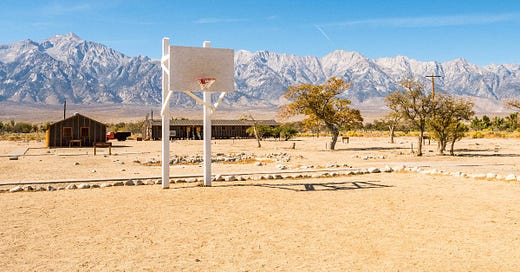A Field Guide to Basketball
Dribble, shoot and score—Lithuania, California, Egypt and more
Field Guide Vol. 247
As we find ourselves a few weeks away from the NBA Finals, we thought we'd turn our attention to basketball beyond the NBA. After the NY Knicks closed out their valiant playoffs run, and the Pacers, Celtics, Timberwolves and Nuggets continue to battle for the U.S. men's title, come with us to explore the global world of hooping.
The J League
By Ky-Phong Tran
In the sixth grade, having fallen in love with the Los Angeles Lakers, their passing wizard Magic Johnson and their five 1980s championships, I asked my father for a basketball hoop in the driveway.
My father was born in Vietnam. In his home country, he was a scholarship boy, a lieutenant and paratrooper and a teacher. In the United States, he sold furniture for a living and grew his own vegetables at home. He was a resourceful man. So instead of going to Big 5 Sporting Goods and buying me a backboard and rim—like any American dad would do—my father actually made my hoop. By hand. One day, he came home with an orange rim, a flat piece of scrap wood and a skill saw. He cut the wood, then screwed the rim into it. Next, he mounted the board directly onto the garage with massive bolts fitted into holes he had drilled into the wall. His finishing touches? Painting the wood white, then stenciling a bright rectangle onto it.
Not long after my dad put up that hoop, a cousin of mine moved to my street. He was six years older than me and a standout basketball player. We connected with two other cousins and began playing on any court we could find that had lights. My cousins were all fatherless Vietnamese young men who had lost their dads to the war, and their sorrow and anger fed into their playing. They moved with skill and speed, but what distinguished them from others was their ferocity. On both offense and defense, they were merciless, a basketball blitzkrieg. They were the kind of players who would win a game, then want to fight afterward, still full of rage.
My basketball training didn’t begin in a park league, the YMCA or a youth camp, but in pickup games with these young men. Men who knew every subtle trick: how to tug the inside of an opponent’s elbow to get open, how to grab your shirt just enough to slow you down, how to jam your pivot foot with a deftly placed knee. Thanks to my father’s homemade court and my cousins’ tutelage, I made up for my late start. I went on to play through high school in strong programs at Long Beach Jordan and Long Beach Poly High. After college, I joined men’s leagues and pickup games in basketball hotspots like Venice Beach and Harlem’s Rucker Park.
My wife and I eventually settled with our kids in Torrance, California. Torrance, I would learn, is a hub of Japanese American culture; its immigrant community goes back generations, and Toyota, Honda and Nissan have all had their national headquarters in the LA County city. Like New York and Chicago, Torrance is also a basketball mecca. It was fate and literally a basketball jump-stop: I was eager to have our two sons play the game that had meant so much to me, and here we were in a place that embraced the sport.
It’s not widely known, but Torrance and other cities with significant Japanese American communities are home to basketball leagues that go back just over a century. In the sprawling delta of Sacramento, there are venerable programs like the Barons, Warlords and Rebels that have produced hundreds of high school varsity players. Silicon Valley boasts clubs like the Ninjas and Zebras, the latter of which was once a powerhouse team that included former NBA guard Rex Walters, who is Japanese American. And Southern California, a hoops hotbed, is home to—among others—the Hollywood Dodgers, the Tigers and the Jets, which routinely send top players to premier college programs.
Nicknamed the “J League,” the Japanese American basketball leagues are made up of teams from local Japanese churches, Buddhist temples and community centers. Participants start as young as kindergarten and can play into their 50s and beyond. With boys’ and girls’ teams at every grade level, and about eight to ten players per team, it’s safe to say there are hundreds of teams and thousands of participants. Multiply that number by a century of players, coaches and parents, and you can see that the leagues have touched the lives of tens of thousands of people, if not more.
Read more from “The J-League” in Stranger’s Guide: California
Did you know?
In 1960, the International Basketball Federation (FIBA) allowed the Egyptian Basketball Federation to begin competing on the world stage. Soon after, eleven other African countries, including Ghana, Morocco, Libya and Sudan joined the federation. Today, every country on the continent is active in the federation and in 2021 the continent's first professional basketball league, the Basketball Africa League, played its first game.
Keep reading with a 7-day free trial
Subscribe to Stranger's Guide to keep reading this post and get 7 days of free access to the full post archives.




